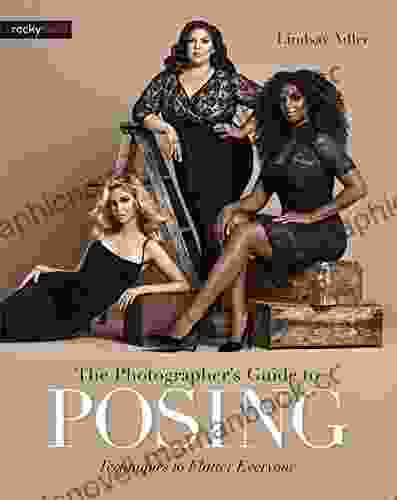100 Photography Tips: Essential Pointers to Capture Stunning Images

Photography empowers us to freeze moments, convey emotions, and tell stories through the art of capturing light. Whether you're an aspiring or experienced photographer, refining your skills is crucial for producing exceptional images. This comprehensive guide presents 100 invaluable tips that will elevate your photography journey and help you snap the perfect photo every time.
Composition and Framing
1. Rule of Thirds: Divide your frame into thirds both horizontally and vertically to create a balanced and visually appealing composition. Place key elements along the lines or intersections for a pleasing arrangement. 2. Leading Lines: Utilize lines within the scene to guide the viewer's eye towards your subject. Natural or architectural elements can create a sense of depth and draw attention to specific features. 3. Negative Space: Don't be afraid to leave empty areas in your frame. Negative space can accentuate your subject, create a sense of mystery, and improve the overall composition. 4. Framing within a Frame: Use natural or architectural elements to create a frame for your subject. This technique can enhance the sense of depth and focus attention on important elements. 5. Symmetry and Asymmetry: Both symmetrical and asymmetrical compositions can be visually pleasing. Experiment with different arrangements to find what best suits the image you want to create.
5 out of 5
| Language | : | English |
| File size | : | 109 KB |
| Text-to-Speech | : | Enabled |
| Screen Reader | : | Supported |
| Enhanced typesetting | : | Enabled |
| Print length | : | 19 pages |
| Lending | : | Enabled |
Lighting and Exposure
6. Golden Hour Magic: The hour after sunrise or before sunset offers a warm, diffused light that flatteringly illuminates subjects and landscapes. 7. Underexpose Slightly: Capture images that are slightly underexposed, as underexposed areas can be adjusted more easily in post-processing than overexposed ones. 8. Expose for the Highlights: In scenes with high contrast, expose for the brightest areas to ensure they retain detail, even if it means sacrificing some shadows. 9. Use a Polarizing Filter: This filter reduces reflections and helps saturate colors, making it ideal for landscapes and outdoor photography. 10. Experiment with Different Lighting Ratios: Vary the ratio between the brightest and darkest areas of your image to create different moods and atmospheres.
Lens and Aperture
11. Choose the Right Lens: Select a lens that balances your desired field of view, aperture, and focal length. Wide-angle lenses offer a broad perspective, while telephoto lenses magnify distant subjects. 12. Control Depth of Field: Adjust the aperture to control the depth of field, or the range of focus in an image. Wide apertures (low f-numbers) create a shallow depth of field, while narrow apertures (high f-numbers) extend the depth of field. 13. Use a Sunstar Effect: Create a starburst pattern around bright light sources by adjusting the aperture to a high f-number. 14. Take Advantage of Bokeh: The out-of-focus background blur created with a wide aperture can enhance the isolation of your subject and add artistic depth to the image. 15. Understand Hyperfocal Distance: Learn to calculate the hyperfocal distance for the lens and aperture you're using to ensure maximum sharpness throughout most of the image.
Subject and Focus
16. Identify Your Subject: Determine the focal point of your image and make sure it's clearly defined and draws attention. 17. Compose Around Your Subject: Use the elements of composition to create a compelling frame that complements your subject. 18. Isolate Your Subject: Use a shallow depth of field to isolate the subject from the background and direct focus on the specific element you want to highlight. 19. Experiment with Angles: Explore different angles to capture unique perspectives and add depth to your images. 20. Use Manual Focus: In certain situations, manual focus allows for precise control over the focus point, ensuring sharp images even in challenging lighting conditions.
Post-Processing and Editing
21. Basic Adjustments: Master the fundamentals of image editing, including adjusting exposure, contrast, highlights, and shadows to enhance the overall quality. 22. Use Tone Curves: Tone curves provide advanced control over the tonal range of your image, allowing for fine-tuning of brightness, contrast, and colors. 23. Experiment with Color Grading: Adjust the color temperature, saturation, and hue to create different moods and atmospheres in your images. 24. Crop Creatively: Reframe and crop your images to improve composition, emphasize key elements, and eliminate distractions. 25. Remove Distractions: Use editing tools to remove unwanted elements or objects from your images, creating a more refined and cohesive final product.
Technical Aspects
26. Use a Tripod: Stabilize your camera with a tripod to minimize camera shake and capture sharp images, especially in low-light conditions. 27. Choose the Right Shutter Speed: Set the appropriate shutter speed to freeze motion or create intentional blur. 28. Learn Aperture Priority Mode: This mode allows you to control the aperture and depth of field while the camera automatically adjusts the shutter speed. 29. Master Manual Mode: Gain complete control over your camera's settings by shooting in manual mode to fine-tune every aspect of your exposure. 30. Use RAW Format: Capture images in RAW format to retain maximum data and flexibility for editing, as RAW files contain more information than JPEGs.
Equipment and Accessories
31. Invest in a Good Camera: While a good camera can enhance your capabilities, it's not the sole determinant of great photography. 32. Choose Versatile Lenses: Start with a few versatile lenses that cover a range of focal lengths, such as a 24-70mm or 70-200mm. 33. Utilize a Filter Kit: Essential filters like circular polarizers and neutral density filters can improve image quality in specific situations. 34. Consider External Flash: An external flash provides greater control over lighting, allowing you to illuminate subjects or create dramatic effects. 35. Use Camera Straps and Bags: Protect your equipment with durable camera straps and bags to keep it safe and accessible during your shoots.
Creative Techniques
36. Long Exposure: Capture motion blur or create unique effects by using a long shutter speed and a tripod. 37. Motion Blur Panning: Follow moving subjects with your camera while panning to create a sense of dynamic motion. 38. Use Reflection and Shadows: Incorporate reflections and shadows into your images to add depth, interest, and artistic flair. 39. Experiment with Double Exposure: Combine two or more images in-camera or through post-processing to create surreal and eye-catching effects. 40. Capture Candid Moments: Observe your surroundings carefully and be ready to capture spontaneous and unscripted moments that tell a story.
Other Essential Tips
41. Learn Your Camera's Features: Familiarize yourself with the functions and buttons of your camera to optimize its potential. 42. Practice Regularly: The more you practice, the more comfortable you'll become with your camera and the more intuitive your photography will become. 43. Seek Feedback and Critique: Share your images with others and ask for constructive criticism to identify areas for improvement. 44. Study the Work of Great Photographers: Analyze the techniques, compositions, and styles of renowned photographers to gain inspiration and develop your own artistic vision. 45. Be Patient: Photography is an art form that takes time and effort to master. Be patient with yourself and enjoy the learning process.
Shooting in Different Environments
46. Landscape Photography: Capture the beauty of nature, utilizing wide-angle lenses and techniques such as long exposure. 47. Portrait Photography: Focus on capturing the character and emotions of your subjects through flattering lighting and composition. 48. Street Photography: Document candid moments and everyday life in public spaces. 49. Macro Photography: Explore the intricate details of small subjects using special lenses and techniques. 50. Night Photography: Embrace the challenges of low-light conditions to create stunning images with long exposures and unique lighting techniques.
Advanced Photography Techniques
51. HDR Photography: Combine multiple exposures to create images with an extended dynamic range and greater detail in both highlights and shadows. 52. Focus Stacking: Combine multiple images taken at different focus points to achieve a larger depth of field and sharp focus throughout the entire image. 53. Time-Lapse Photography: Capture gradual changes over time by taking a series of images at regular intervals and combining them into a video. 54. Astrophotography: Photograph celestial objects, capturing the beauty of the night sky. 55. Aerial Photography: Use drones or other aerial platforms to capture unique perspectives and breathtaking landscapes from above.
Inspiration and Creativity
56. Follow Your Passion: Identify the subjects and themes that inspire you and focus on capturing images that resonate with your interests. 57. Embrace Curiosity: Explore different perspectives, experiment with new techniques, and be open to unexpected opportunities. 58.
5 out of 5
| Language | : | English |
| File size | : | 109 KB |
| Text-to-Speech | : | Enabled |
| Screen Reader | : | Supported |
| Enhanced typesetting | : | Enabled |
| Print length | : | 19 pages |
| Lending | : | Enabled |
Do you want to contribute by writing guest posts on this blog?
Please contact us and send us a resume of previous articles that you have written.
 Top Book
Top Book Novel
Novel Fiction
Fiction Nonfiction
Nonfiction Literature
Literature Paperback
Paperback Hardcover
Hardcover E-book
E-book Audiobook
Audiobook Bestseller
Bestseller Classic
Classic Mystery
Mystery Thriller
Thriller Romance
Romance Fantasy
Fantasy Science Fiction
Science Fiction Biography
Biography Memoir
Memoir Autobiography
Autobiography Poetry
Poetry Drama
Drama Historical Fiction
Historical Fiction Self-help
Self-help Young Adult
Young Adult Childrens Books
Childrens Books Graphic Novel
Graphic Novel Anthology
Anthology Series
Series Encyclopedia
Encyclopedia Reference
Reference Guidebook
Guidebook Textbook
Textbook Workbook
Workbook Journal
Journal Diary
Diary Manuscript
Manuscript Folio
Folio Pulp Fiction
Pulp Fiction Short Stories
Short Stories Fairy Tales
Fairy Tales Fables
Fables Mythology
Mythology Philosophy
Philosophy Religion
Religion Spirituality
Spirituality Essays
Essays Critique
Critique Commentary
Commentary Glossary
Glossary Bibliography
Bibliography Index
Index Table of Contents
Table of Contents Preface
Preface Introduction
Introduction Foreword
Foreword Afterword
Afterword Appendices
Appendices Annotations
Annotations Footnotes
Footnotes Epilogue
Epilogue Prologue
Prologue David L Roll
David L Roll Clement Clarke Moore
Clement Clarke Moore Matthias T Meifert
Matthias T Meifert Philip Richardson
Philip Richardson Claire E Honess
Claire E Honess Paula Darwish
Paula Darwish Mark R Anspach
Mark R Anspach Grace Onyema
Grace Onyema Kathleen Davis
Kathleen Davis Noelle Ihli
Noelle Ihli Zeba Ali
Zeba Ali Christy Oslund
Christy Oslund Robert Spencer
Robert Spencer Sabaa Tahir
Sabaa Tahir Dana Suskind
Dana Suskind Faith Hunter
Faith Hunter Mel Dunay
Mel Dunay Trisha Yearwood
Trisha Yearwood Cecelia Holland
Cecelia Holland Juby Aleyas Koll
Juby Aleyas Koll
Light bulbAdvertise smarter! Our strategic ad space ensures maximum exposure. Reserve your spot today!

 Robert BrowningMy Hero Academia Vol 22: That Which Is Inherited - An Epic Tale of Heroes and...
Robert BrowningMy Hero Academia Vol 22: That Which Is Inherited - An Epic Tale of Heroes and... Rubén DaríoFollow ·3.5k
Rubén DaríoFollow ·3.5k Jermaine PowellFollow ·6.2k
Jermaine PowellFollow ·6.2k Diego BlairFollow ·12.7k
Diego BlairFollow ·12.7k Ivan CoxFollow ·7.2k
Ivan CoxFollow ·7.2k Larry ReedFollow ·6.7k
Larry ReedFollow ·6.7k DeShawn PowellFollow ·3.9k
DeShawn PowellFollow ·3.9k Floyd RichardsonFollow ·2.8k
Floyd RichardsonFollow ·2.8k Jay SimmonsFollow ·4.9k
Jay SimmonsFollow ·4.9k

 Rex Hayes
Rex HayesWorld of Dead Volume Issue: An In-Depth Analysis
The World of Dead volume issue...

 Nathan Reed
Nathan ReedHard Lessons Learned from ERP Rollouts: A Hivemind...
Enterprise...

 Fernando Bell
Fernando BellWith the Light, Vol. 1: Illuminating the Extraordinary...
The advent of parenthood is a...

 Wesley Reed
Wesley ReedNo Helping Hand: True Story of Deadly Waves
In December 2004,...

 Ruben Cox
Ruben CoxIntroduction to Electrodynamics by David Griffiths: A...
to Electrodynamics by...
5 out of 5
| Language | : | English |
| File size | : | 109 KB |
| Text-to-Speech | : | Enabled |
| Screen Reader | : | Supported |
| Enhanced typesetting | : | Enabled |
| Print length | : | 19 pages |
| Lending | : | Enabled |











